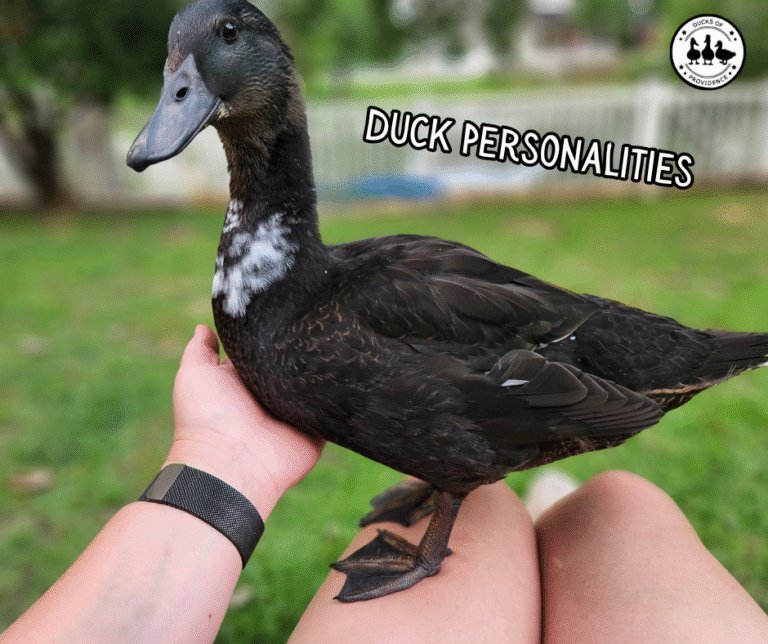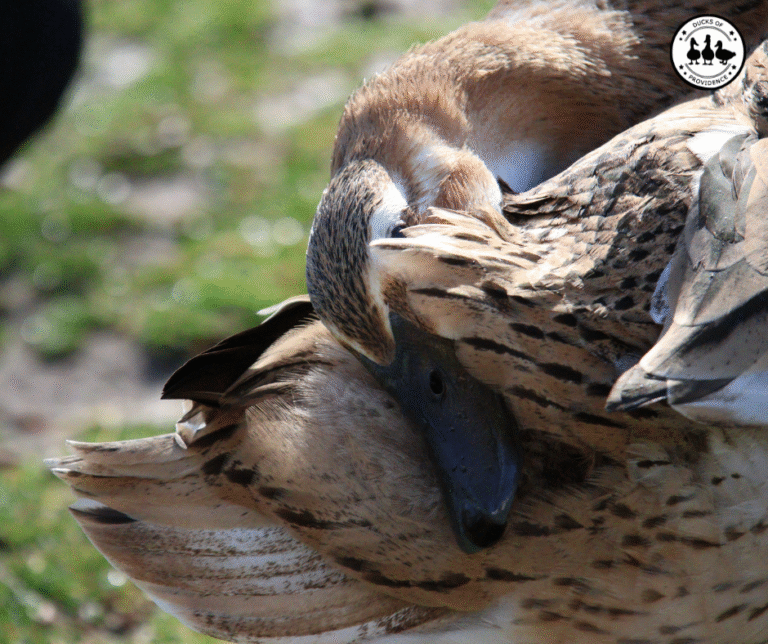
Duck Markings and Leg Bands: Identification and Options for Pet Ducks
Keeping a flock of pet ducks means learning to recognize each bird as an individual, but sometimes that’s easier said than done, especially when several look alike. Duck markings and leg bands are simple tools that help owners identify their ducks, track health and breeding records, or even highlight each duck’s unique personality. Just like a collar on a dog or cat, a leg band can serve as both a form of identification and a symbol of care. In this guide, we’ll explore why people use markings and leg bands for ducks, the different options available, and how to keep your flock safe while doing so.
Ducks of Providence is free, thanks to reader support! Ads and affiliate links help us cover costs—if you shop through our links, we may earn a small commission at no extra cost to you. Thanks for helping keep our content free and our ducks happy! 🦆 Learn more
Why People Mark or Band Their Ducks
Duck markings and leg bands serve many purposes, from keeping a backyard flock organized to meeting formal requirements in breeding or conservation. Below are the most common reasons, each with its own unique value.
Flock Identification
When you have multiple ducks that look alike, telling them apart can be a daily challenge. This is especially true for breeds with uniform coloring, like Pekins or Khaki Campbells. Bands allow you to instantly recognize who is who, which makes feeding, letting them out into the yard, or checking the flock at night much easier. Even in smaller flocks, leg bands can prevent mix-ups when two ducks share similar feather patterns.
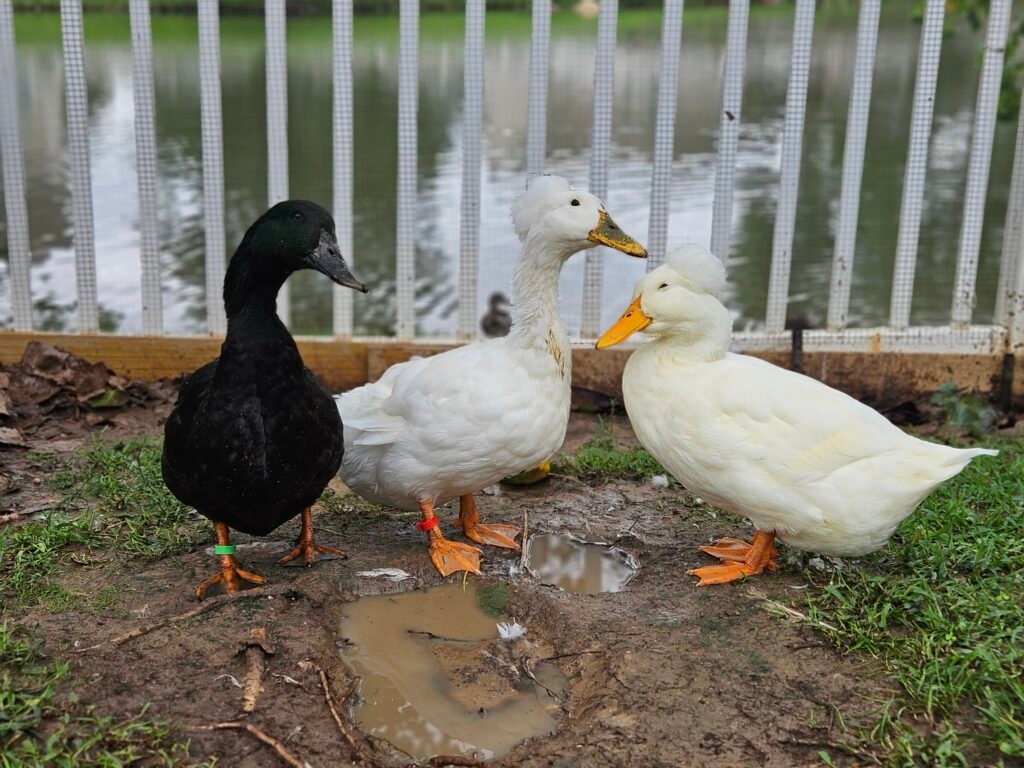
Breeding Records
For breeders, leg bands are indispensable tools that provide structure and accuracy in record-keeping. A simple band can carry a great deal of information about a duck’s history. By assigning different colors, numbers, or codes, breeders can track parentage, egg production, and age with ease. This organization is especially valuable in larger flocks where ducks may look nearly identical.
Leg bands also help ensure that breeding practices remain responsible. Knowing exactly which ducks belong to which line allows breeders to avoid accidental pairings that could lead to inbreeding and health problems. With clear identification, it becomes possible to manage genetic diversity across generations and strengthen desirable traits in a flock.
Numbered metal bands are especially popular in breeding programs because they last for many years and provide unique identifiers for each bird. Plastic options with printed numbers or color codes are also useful for smaller operations, particularly when tracking multiple lines at once. In both cases, accurate records paired with reliable identification are essential for maintaining healthy, well-managed breeding flocks.
Health Monitoring
Health care is another important reason to use bands. Ducks sometimes need individual attention, whether it’s for medication, recovery after surgery, or long-term conditions like bumblefoot. A band acts as a quick visual reminder of which duck needs special care. For example, one duck might wear a temporary band while she’s on antibiotics, so you don’t forget to catch her at feeding time. This simple step can make daily flock management much smoother.
Showing and Exhibitions
If you plan to show your ducks, leg bands are often a requirement. Poultry shows rely on bands to confirm the identity of each bird so that judges know they are evaluating the correct entry. Bands also help prevent confusion when multiple birds of the same breed and age are competing.
Legal Purposes
In some cases, banding isn’t just a choice. It’s a legal obligation. Many U.S. states require that captive-bred Mallards be banded or toe-clipped so they can be distinguished from wild populations. This rule helps prevent confusion if a domestic Mallard escapes and joins wild flocks, ensuring that wildlife officials and hunters can clearly tell the difference.
Owners of certain exotic or protected duck species may also be required to use permanent identification methods, such as leg bands or microchips, to comply with permit rules. These regulations are designed to keep clear records of ownership and to support responsible management of non-native species.
While most backyard duck keepers won’t need to worry about these requirements, it’s important for anyone considering Mallards or exotic breeds to check their local laws. Banding in these cases is not just a practical tool but a necessary step to meet legal obligations.
Pet Identification
For many backyard duck keepers, leg bands serve a role similar to collars on dogs or cats. They provide a simple way to identify each duck, but they also reflect personality and individuality. In our flock, every duck has a band color chosen just for them. Simon, our drake, wears a bright green band that matches his confident nature and looks striking against his black-greenish plumage. Krümel wears purple, a softer shade that suits her gentle and calm personality.
We also use leg bands for a very practical reason. Behind our property is a pond where wild and feral ducks live year-round. During the winter, even more migratory species visit. Having bands on our ducks helps ensure there’s no confusion between our flock and the wild ducks. On occasion, Muffin, Krümel, or Ronja have managed to fly over the fence and wander toward the pond. With their bands, it’s immediately clear they belong to us, and we can bring them back inside without anyone mistaking them for wild ducks. The bands act as visible identifiers, making it clear these are pets, not ducks we’ve taken from the pond.
For us, the bands are more than markers, they symbolize connection. They make it easy for visitors to learn who’s who, they distinguish our flock from wild birds nearby, and they remind us daily that our ducks are not just farm animals. They are beloved companions and family members, each with their own story and personality.
Research and Conservation
Banding isn’t just for backyard keepers and breeders. It has been one of the most time-tested techniques for studying wild waterfowl. Originally, banding programs helped scientists map migration routes, identify important wintering areas, and document how strongly ducks return to their breeding sites year after year. Over time, banding has provided even more insight: it allows researchers to estimate survival rates, population sizes, and the effects of hunting regulations on different species.
In North America, banding data has been central to the flyway-based management system that guides waterfowl conservation. For nearly 80 years, band recovery reports have helped shape hunting regulations, habitat protection, and conservation strategies. This long history of banding allows managers to track how duck populations and migration patterns have shifted over time and to anticipate future changes.

Today, waterfowl banding remains a cornerstone of conservation. By understanding where birds go, how long they live, and how populations respond to environmental changes, scientists and wildlife managers can better protect both ducks and the habitats they depend on. Hunters and conservationists are encouraged to report recovered bands through the official U.S. Bird Banding Program website (www.reportband.gov), which helps ensure waterfowl remain abundant for generations to come. Learn more about banding of wild ducks at ducks.org or the U.S. Fish & Wildlife Service.
Options for Marking Ducks
There are several ways to mark or band ducks, ranging from temporary identifiers to more permanent methods. Each option comes with its own benefits and considerations.
Zip Tie-Style Bands
Some leg bands work just like zip ties (like ZBands): they’re lightweight, inexpensive, and easy to apply. Many are designed specifically for poultry and come in a variety of colors. Some versions even allow you to add little charms or tags, which can make the bands fun and more personalized for pet ducks. Personally, I’m not the biggest fan of the charm option, since there’s always a risk that a charm could fall off and be ingested by a curious duck. This can lead to serious health problems such as metal poisoning or an impacted crop. The bands themselves, however, can be a practical choice for adult ducks, as long as you select the right size. The drawback is that once applied, they usually can’t be adjusted or reused, so they’re best suited for ducks that won’t be growing much more.
Plastic One-Piece Leg Bands
These solid plastic bands are available in different sizes and colors. They can be either blank or pre-numbered, which makes them popular with breeders who want to keep records. Because they’re one-piece, they’re sturdy and less likely to come loose, but they need to be chosen in the correct size to avoid slipping off or causing discomfort. This is the type we use, and we have purchased the leg bands from Happy Hen Treats for our flock because they come in small packs of different sizes and lovely colors.
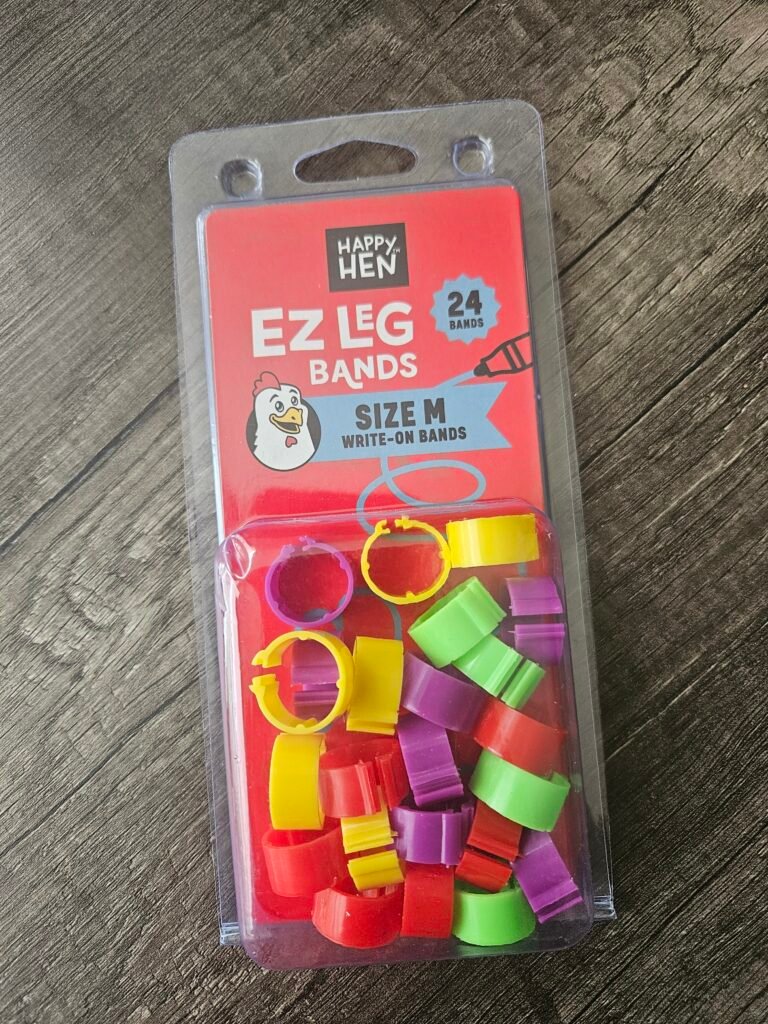
Spiral Bands
Spiral bands are flexible plastic coils that wrap around the leg. They’re easy to apply and remove, making them a good choice for temporary identification. However, they can sometimes stretch out or fall off, so they need to be checked regularly.
Adjustable Snap Bands
These adjustable and reusable bands can be opened and closed, which makes them easy to resize as needed. They’re a practical choice for growing ducks or for owners who want the flexibility to change band colors over time. However, some of these bands are not very reliable. The closing mechanism can be faulty, and they tend to break or pop open more easily than one-piece or spiral designs. If you use them, be sure to check them frequently and replace any that show signs of wear.
Metal Leg Bands
Metal bands are one of the most durable and permanent options for duck identification. They’re commonly used by breeders, researchers, and wildlife organizations because they don’t stretch, fade, or break as easily as plastic bands. Metal bands often come with engraved numbers, which makes them useful for keeping long-term records.
However, they must be fitted carefully to avoid injury. A band that is too small can cut into the leg as the duck grows, while one that is too large may slip off or snag on fencing. Sharp edges can also be a risk if the band becomes damaged. For pet flocks, metal bands can feel a bit heavy-duty, but they may be a good option if you need a permanent
Toe Clipping
Toe clipping is a permanent method sometimes used by breeders, and in some cases, it’s required for legally kept Mallards or other regulated species. It involves removing the small back toe (the hind toe) when the duck is still a duckling. This creates a lasting identifier that can’t be lost the way a band might be. While effective, it is invasive and considered outdated by many pet owners. For companion ducks, other methods of identification are usually preferred unless toe clipping is specifically required by law.
Feather or Livestock Markers
For short-term identification, some owners use livestock-safe chalk, paint, or markers to make temporary marks on feathers. These fade with preening, bathing, or molting, so they’re not a long-term solution but can be useful in a pinch.
Microchips
Implanted by a veterinarian, microchips are permanent identifiers similar to those used in dogs and cats. While reliable, they’re not practical for everyday recognition since you need a scanner to read them. They are, however, a safe option for long-term identification, especially in flocks that travel or are kept in areas with wild ducks.
Microchips are often sold online, including through Amazon, but it’s always best to have them implanted by a qualified veterinarian to ensure correct placement and to minimize stress or injury to your duck.
Natural Markings
In small flocks, natural differences in feather patterns, bill colors, or even vocalizations can be enough to tell ducks apart. This works well when each duck looks distinct, but can be challenging with large groups or breeds that all share similar features.
Safety and Welfare Considerations
While leg bands and markings can be helpful, the safety and comfort of your ducks should always come first. Improperly fitted or poorly chosen bands can do more harm than good. Here are some important guidelines to follow:
Choose the Correct Band Size
A properly sized band should fit snugly without restricting movement. If it’s too tight, it can cut off circulation, leading to swelling, pain, or even permanent injury. If it’s too loose, it may fall off or get caught on fencing, wire, or vegetation. Always follow sizing charts from the manufacturer and consider that drakes usually need a slightly larger size than hens.
Check Regularly
Ducklings grow incredibly fast, and a band that fits one week may become dangerously tight the next. Adult ducks can also change in weight and size, especially during laying season or molting, so regular checks are essential. A quick weekly inspection when handling or herding your ducks can prevent issues before they develop.
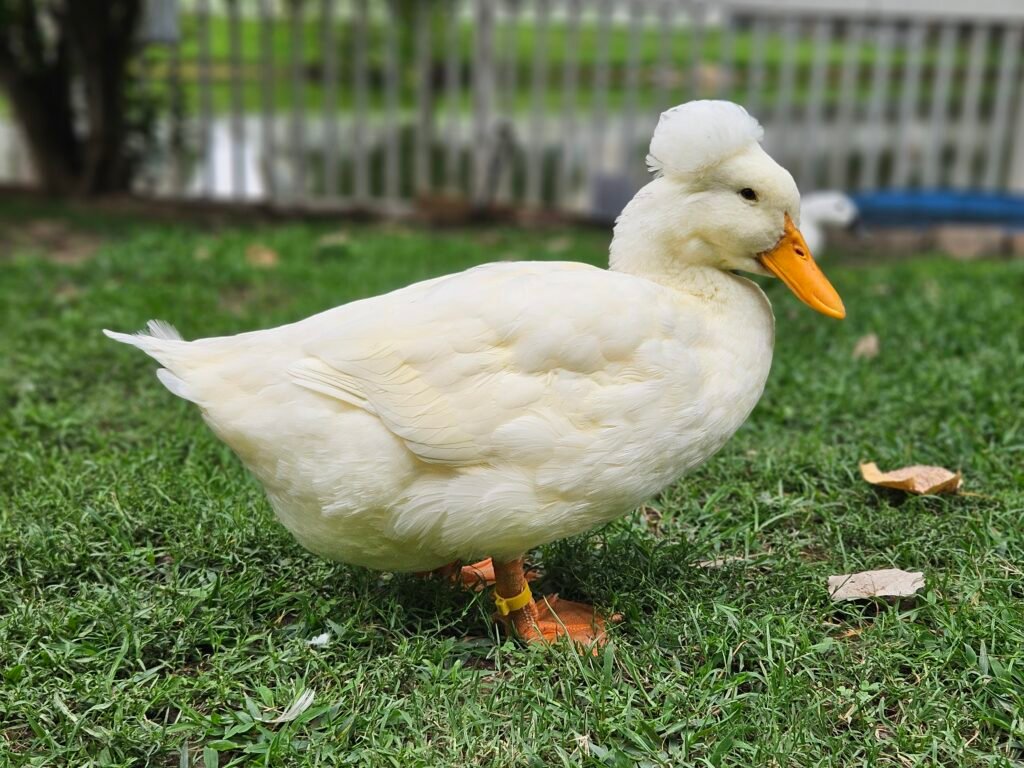
Inspect for Wear and Damage
Even high-quality bands can crack, warp, or develop sharp edges over time. Broken or rough bands can rub against the leg, causing sores or cuts. Make it a habit to inspect bands whenever you clean the run or do a health check, and replace any that look worn out.
Avoid Makeshift Options
Never use string, wire, rubber bands, or anything not designed specifically for poultry or waterfowl. These can tighten around the leg, cut into the skin, or become embedded over time. Only use purpose-made bands that are smooth, rounded, and safe.
Watch for Snagging Hazards
Even with a proper fit, bands can occasionally get caught on hardware cloth, wire fencing, or netting. To minimize this risk, make sure your duck’s enclosure is free of sharp edges and that bands are checked often.
Remove Bands if Needed
If you notice redness, swelling, or irritation around the leg, remove the band immediately. It’s always better to go without a band than to risk long-term injury. Some owners rotate between different types of bands or take them off temporarily during molting to give ducks a break.
Practical Tips From My Flock
In our home, leg bands serve the same role as collars do for dogs or cats. They aren’t just about practicality; they’re a way to recognize and celebrate our ducks as individuals. Each duck has a band color chosen to reflect their unique personality, and over time, those colors have become part of how we see them.
Technically, we don’t need bands to tell our ducks apart. We have a small flock, and to us, each duck is easily recognizable by their color, markings, behavior, or voice. But we still chose to give them bands because we wanted them to have their own unique “collar.” It’s become a way to highlight their personalities and make them stand out even more.
For example, Simon, our drake, wears a bold green band that complements his black-greenish plumage and matches his confident nature. Krümel wears a soft purple band that perfectly reflects her gentle and slightly shy demeanor. Visitors often learn the ducks’ names faster thanks to the colors, and it’s fun for us to see how well the colors suit each duck.
We’ve also been considering taking it a step further. Adding their names to the bands, and possibly even our phone number. Since our property backs onto a pond with wild and feral ducks, and because Muffin, Krümel, or Ronja occasionally manage to fly over the fence, this extra detail could provide peace of mind. If one of them wanders too far, anyone who finds her would immediately know she belongs to us and how to reach us.
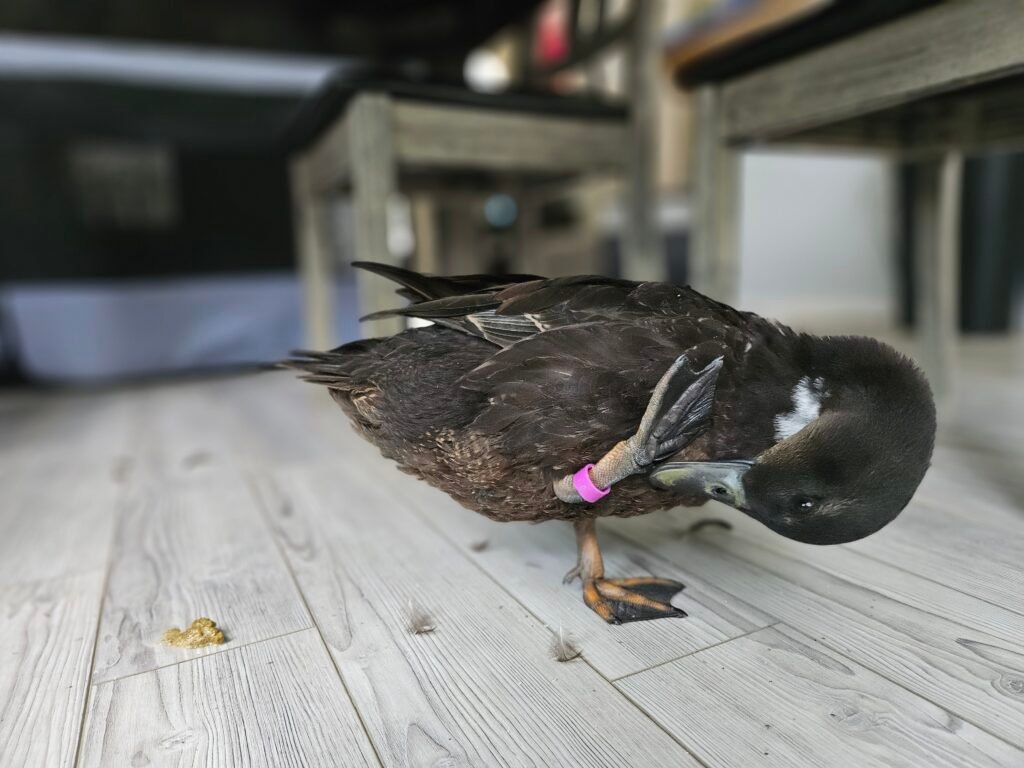
One thing to keep in mind is that some ducks may need time to get used to their bands. A few of ours nibbled at them curiously at first, but they quickly lost interest within a couple of days. If you try bands for the first time, just keep an eye on your ducks to make sure they’re comfortable and not irritating the bands.
For us, the bands aren’t about necessity, they’re about giving each duck a symbol of identity and belonging. They’ve become part of our flock’s story and a way for us to show that our ducks are truly family.
Final Thoughts
Leg bands and markings can serve many purposes, from record-keeping and health monitoring to meeting show or legal requirements. But for small backyard flocks like ours, they’re often less about necessity and more about celebrating each duck as an individual. With the right size, material, and regular checks, leg bands are a safe and simple way to highlight personality while also offering peace of mind if a duck ever strays.
For us, bands act much like collars on dogs or cats. A visible reminder that our ducks are pets and family, not just part of the scenery around the pond. Whether you use them for organization, protection, or pure fun, the key is to choose what works best for your flock and always keep your ducks’ comfort and welfare at the center of the decision.








